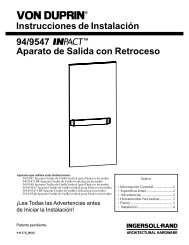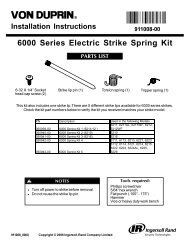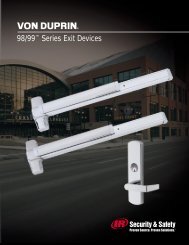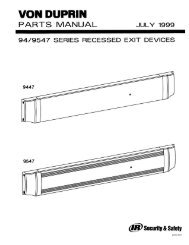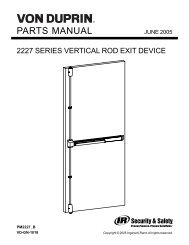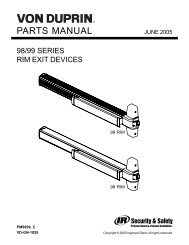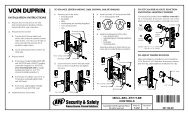Fire, Life Safety & Accessibility Codes - Von Duprin
Fire, Life Safety & Accessibility Codes - Von Duprin
Fire, Life Safety & Accessibility Codes - Von Duprin
You also want an ePaper? Increase the reach of your titles
YUMPU automatically turns print PDFs into web optimized ePapers that Google loves.
Access-Controlled Egress Doors (1012.7)<br />
Entrance doors in a means of egress and entrance doors to tenant<br />
spaces in Group B, M, R1 or R2 buildings may be equipped with an<br />
approved entrance and egress access control system which complies<br />
with the following:<br />
· an approved listed releasing sensor/device, mechanical or<br />
electrical, must be provided on the egress side to detect an<br />
occupant attempting to exit, doors shall unlock by a signal<br />
from or loss of power to releasing device<br />
· loss of power to the locking hardware must automatically<br />
unlock the doors<br />
· manual unlocking device required for emergency unlocking<br />
purposes only<br />
· manual unlocking device must be located 40" to 48"<br />
vertically above the floor and within 5' of the doors<br />
· ready access to manual unlocking device must be provided,<br />
and signage is required<br />
· operation of device shall result in direct interruption of<br />
power to the lock, independent of the access control<br />
system electronics<br />
· activation of device shall unlock doors for 30 seconds<br />
minimum<br />
· activation of the fire protection system (if the building has one)<br />
shall unlock the doors, doors to remain unlocked until the fire<br />
protection system is reset<br />
· entrance doors in Groups B or M shall not be secured from the<br />
egress side when the building is open to the general public<br />
· entrance doors in buildings having a mechanical means of egress<br />
in conjunction with an electric strike shall be latched when not<br />
energized<br />
· independent standby power may be used on doors which provide<br />
immediate egress upon a signal from a listed releasing sensor/<br />
device and a signal from the fire protection system (if the building<br />
has one), as described in 1012.6.1 exception 1 (Special Locking<br />
Arrangements)<br />
877.840.3621 • www.securitytechnologies.ingersollrand.com<br />
Special Egress Requirements by Occupancy (1019 - 1027)<br />
· Key-Operated Locks - for main exterior exit doors on Group A-2<br />
with an occupancy of 300 or less (1019.7.1), main exterior<br />
exit doors in Group B (1020.3), Group F (1022.3), Group M<br />
(1025.2), and Group S (1027.4):<br />
· key locking devices may be used on the egress side if:<br />
· readily visible durable sign on or adjacent to the<br />
door states "THIS EXIT TO REMAIN UNLOCKED<br />
WHEN THIS BUILDING IS OCCUPIED" -<br />
1" letters on a contrasting background<br />
· locking device must be readily distinguishable<br />
as locked<br />
· main exit door is a single door or one pair of doors<br />
· when unlocked, the door or both leaves of the<br />
pair must be free-swinging<br />
· code official may revoke the use of a key locking<br />
device for due cause<br />
· Panic Hardware - means of egress doors from an area of a<br />
Group A occupancy (1019.7.2) and means of egress doors from<br />
an area of a Group E occupancy with an occupant load of 100<br />
or more<br />
· may have a latch or lock only if it is panic hardware or<br />
fire exit hardware, which releases when a force of no more<br />
than 15 lb. is applied in the direction of exit travel<br />
· releasing devices may be bars or panels extending at<br />
least half the width of the door, mounted between<br />
30" and 44" above finished floor<br />
· panic hardware used on a labeled fire door must<br />
be labeled as fire exit hardware<br />
· panic hardware used on balanced doors must be the<br />
pushpad type and the pad shall not extend more than<br />
1/2 the width of the door measured from the latch side<br />
· Group I Locks (1024.1.3) - patient rooms or tenant space<br />
egress doors must not be lockable except in places of restraint<br />
or detention<br />
· Group I Restrained - refer to section 1024.2.8 and 1024.2.9<br />
for several exceptions<br />
· Dwelling Unit Locks (1026.4) - night latch, deadbolt, or security<br />
device is acceptable on exit doors from dwelling units and hotel<br />
guest rooms if devices are openable from the inside without a key,<br />
tool, special knowledge or effort, and the device is mounted no<br />
more than 48" above finished floor<br />
15



